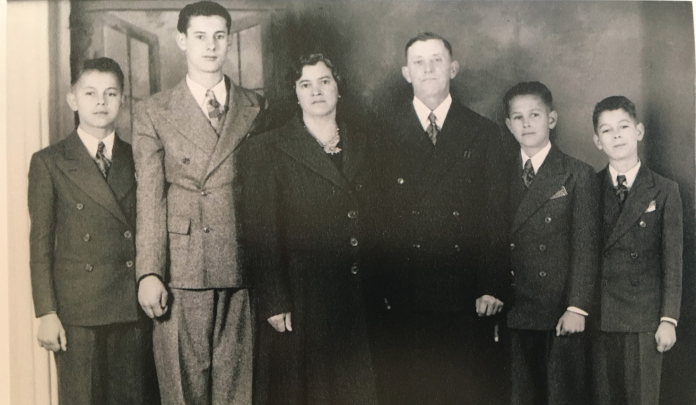
Gilroy resident Frank Louis Masoni died in combat just two days after landing with the U.S. Marine Corps at Tarawa Atoll in the South Pacific in November 1943. Nearly three-quarters of a century later, in the summer of 2017, his remains were positively identified by military officials, and his South County descendants will finally get to bury him.
The Defense POW/MIA Accounting Agency is in the process of transporting Masoni’s full skeletal remains—which have been buried in an unnamed grave at the National Memorial Cemetery of the Pacific in Honolulu for decades—to his 90-year-old brother, Richard.

Richard, who still lives in Gilroy, and his sons, daughters and other family are planning a Nov. 18 burial service.
“I’m so happy he’s getting a chance to return home after all these years,” said Gilroy resident Lanna Sandoval, Frank Masoni’s niece and Richard’s daughter. “It’s so emotional. I wish his other brothers would have had the chance to be alive during this time. And I’m happy my dad has the opportunity to see this in his lifetime.”
Frank Masoni was the oldest of four brothers who grew up in a home on Chestnut Street—now Lewis Street—in Gilroy. Their parents, Clorinda and Salvatore Masoni, were Italian immigrants. All four of their sons served in the military.
Frank Masoni enlisted first at the age of 20, and went to Marine Corps basic training in South Dakota before his deployment to the South Pacific theater of World War Two.
Richard, the youngest of the four siblings, was 16 when he dropped his oldest brother off for his trip to basic training at the bus station in Gilroy.
“He didn’t realize that would be the last time he would see him,” Sandoval said.
Sandoval and her sister Clorinda Sergi shared these details of their family history one recent afternoon at Sergi’s Morgan Hill home. Although Masoni’s nieces and nephew never met their uncle, they grew up hearing stories about him and confirmed he was a dutiful older brother.
“He always looked out for Dad,” Sandoval said. “He smoked, but he wouldn’t give Dad any cigarettes.”
The government notified Frank Masoni’s parents in December 1943 that their son, an Assistant Cook in the Marine Corps, died in combat Nov. 21.
Although his death was confirmed, the location of his remains was “unknown” due to the massive number of casualties on the battlefield, and the lack of sophisticated identification methods at the time, according to Masoni’s official government file, copies of which were provided to his brother and nieces in August.
‘Horrendous’ battle
During the Battle of Tarawa, Masoni was assigned to Headquarters Company, 2nd Battalion, 2nd Marine Division. Specifically, he participated in the invasion of Betio Island.
“Its personnel, men primarily in support jobs, were not normally used as infantry, but during the first two days of fighting on Betio, every man supported the fighting in any way possible,” reads the DPAA’s narrative of the battle and Masoni’s involvement.
Sandoval added, “The battle was so horrendous. He survived day one, and died the second day.”
As soldiers died during the battle, the living gathered their bodies and moved them to collection points for burial. The bodies received temporary burials on the island or, in some cases, burials at sea.
“The Marines just buried as they went, and made makeshift graves,” Sergi said. “He did not have his dog tags on him when he died.”
The remains of hundreds of American soldiers who died in the Tarawa Atoll were then transported to other locations in efforts to identify them, according to Masoni’s file. By 1949, “after every effort available at the time to identify the remains,” the bodies of Masoni and other soldiers were buried at the National Memorial Cemetery of the Pacific, also known as the “Punchbowl” cemetery.
Then in October 2016, DPAA gained authorization to re-examine the remains of soldiers who died at Betio Island and exhumed numerous graves, Masoni’s among them. Officials identified Masoni by comparing dental x-rays, a chest radiograph and other records with his skeletal remains.
‘Been a long time’
That led to DPAA’s contact with Richard Masoni this summer, and the promise that the family will finally be able to bury Frank Masoni’s remains—as his parents wanted.
The government’s file on Masoni’s service and death includes copies of six hand-written letters sent by his mother to the government between 1944 and 1948, reminding officials that she was still waiting for his remains.
“I am very much interested in having his body returned home. Would appreciate all you can do,” reads a November 1946 letter from Frank Masoni’s mother to the General Accounting Office in Washington, D.C.
Frank Masoni didn’t have any children, but he has a large crew of surviving nieces, nephews and their families, many of whom still live in South County.
“The Masoni family can now have closure as we ponder the fact that freedom isn’t free,” Sandoval added.
Richard Masoni’s daughters said the return of his brother has been too emotionally overwhelming for him to speak extensively about it. But he said in a written statement delivered by Sandoval, “It’s been a long time and I’m glad it’s happening.”













Wow, what a great story. Glad he finally will get the burial he deserves.